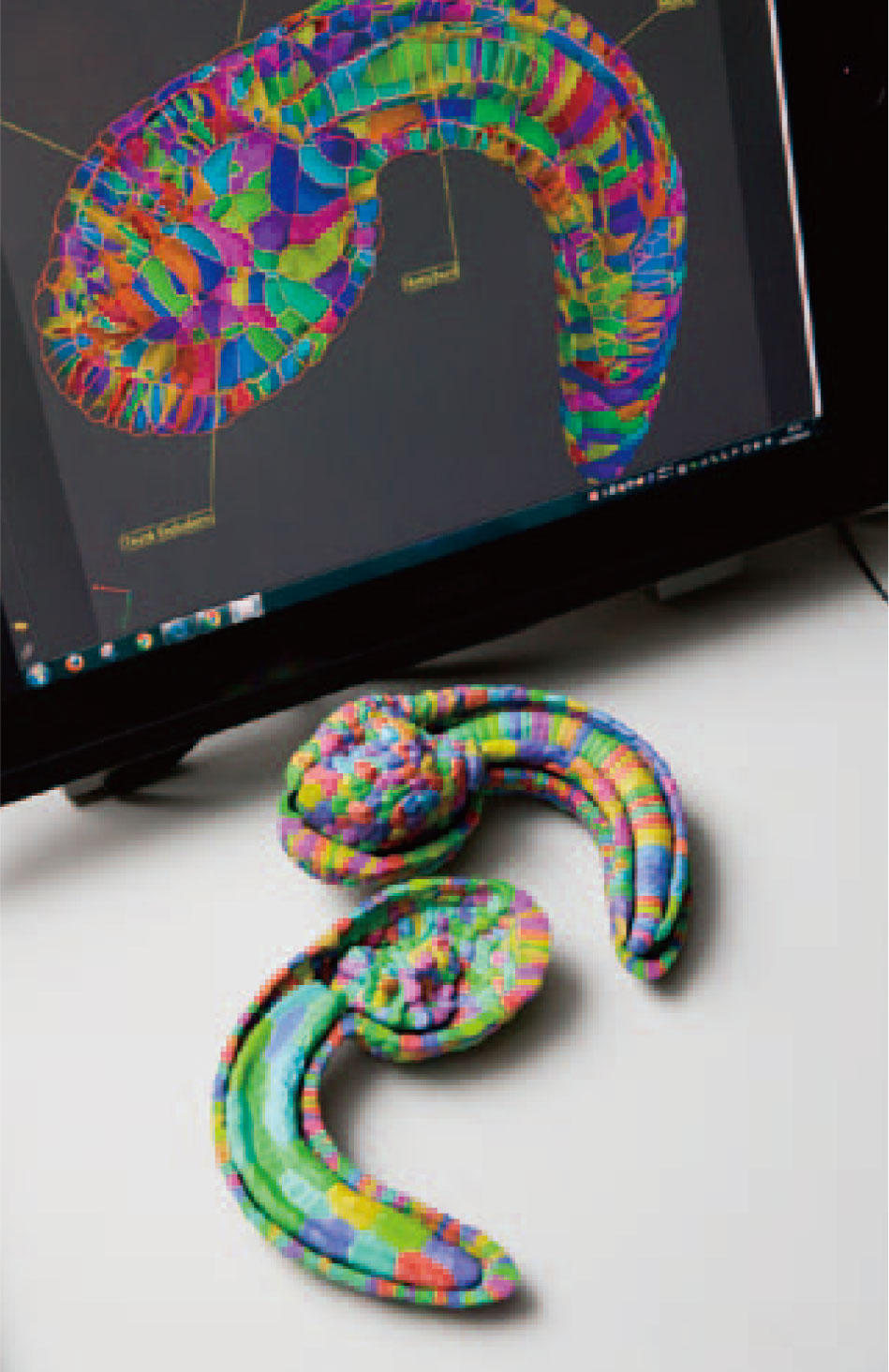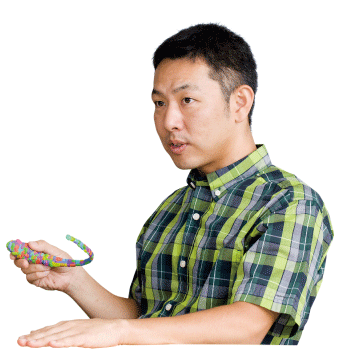- Home
- New Kyurizukai
- Development and Evolution
from Keio's Faculty of Science and Technology
Development and Evolution
from Keio's Faculty of Science and Technology
Investigation into morphogenesis and
evolution of animals using a simple
model animal, the sea squrt
(ascidian, tunicate)
I’ve pursued my favorite study while occasionally facing trouble and being at a loss
“It’s incredible that I have been able to maintain my interest in the sea squirt (ascidian, tunicate) for such a long time thus far,” utters Dr. Hotta with an overflowing enthusiasm for this study on his face. Although he was fond of biology as a child, he had long been unsure about developing this fondness in choosing a researcher’s career as a biology specialist, he confesses. In fact, there were a number of occasions in the past when he asked himself, “Will it be possible for me to accomplish this challenge?” Let’s listen to Dr. Hotta on his past thoughts and how he has followed the path of a researcher.
Kohji Hotta
Dr. Hotta graduated from the Department of Biology, Faculty of Science, Hokkaido University. He encountered the sea squirt (in other words, “ascidian”, “tunicate”) when studying at the Kyoto University Graduate School of Science. He completed the doctoral course at the Kyoto University Graduate School of Science. He continued to study at the National Institute of Genetics (Bioinformatics & DDBJ Research Center) as a postdoctoral fellow of the Japan Society for Promotion of Science, the National Institute for Basic Biology (Morphogenesis Division) and the Naples Marine Station, Stazione Zoologica Anton Dorn in Italy. In 2005, he became a research assistant for the Keio University’s Department of Biosciences and Informatics, was promoted to research assistant in 2007, and then to the current position as assistant professor in 2009. Dr. Hotta’s specialties are evolutionary developmental biology, molecular biology, bioimaging and bioinformatics.
The Research
Featured in this issue is Assistant Professor Kohji Hotta, who pursues research into development and evolution of organisms using the sea squirt (ascidian, tunicate).
Shedding light on the mechanism of development and evolution of organisms using the sea squirt (ascidian, tunicate)
Making the most of state-of-the-art experiment methods and techniques to promote research
In bioscientific research projects, the outcome of each project can vary largely depending on “what subject one chooses.” When he was a graduate student, Assistant Professor Kohji Hotta of the Department of Biosciences and Informatics encountered a marine organism known as the “sea squirt (ascidian, tunicate).” Ever since then, he has focused on research using sea squirts. We asked Dr. Hotta about his inexhaustible interest in the sea squirt and the latest results of his study of this organism.
Sea squirt — an organism called a “relative of Homo sapiens”
Do you happen to know a marine organism called the sea squirt? Sea squirts can be found in calm sea areas where currents are mild, such as canals and yacht harbors. Some varieties are cultivated as seafood. When sticking to craggy surfaces, sea squirts just look like plants, but they are actually an animal that has a heart and preys on plankton.
Asked about his impression of this sea animal, Dr. Hotta says, “Maybe because I have a yearning for plants.” The reason? – Whereas sea squirt larvae that have just been hatched from eggs look like tadpoles and swim around in the water wagging their tails, they lose the tail and muscles that were used to move the tail when grown up, and dare to choose a stationary lifestyle. Another feature that makes the sea squirt resemble a plant is that it is capable of producing cellulose.
“The sea squirt is an intriguing animal with a number of distinctive characteristics. For example, it may interest you to know that if you follow the sea squirt’s path of evolution, you will know that it is one of the relatives of vertebrates, including Homo sapiens.” In the process of forming its tail, a sea squirt larva extends its tail by making a “notochord” inside the body, which will extend the body. We human beings also have the notochord (later to be replaced by the vertebra). This is why the sea squirt can be identified biologically as a relative of Homo sapiens. As such, if we can find points in common between the sea squirt and Homo sapiens in their processes of development (from the egg to the forming of the basic body), it will shed light on the most primordial structure of organisms. This is the significance of research being undertaken into development of organisms using the sea squirt as a model. As is pointed out “the process of ontogeny repeats that of phylogeny,” the development process of a given animal looks as if the animal is following the process of its evolution. So it is safe to say that the study of development will lead to the elucidation of the evolution process.
Why does the tail grow?
“By having a tail, the sea squirt larva acquired an overwhelming driving force unlike what it used to be as an organism drifting with cilia. It also became possible for the sea squirt larva to move on its own will thanks to the central nervous system that developed at the same time. Why did its tail take this shape? My focus of interest now is moving to this question,” remarks Dr. Hotta. With a model of a Coina intestinalis larva in his hand, he explains that the tail is a complex structure made up of various organs, such as the notochord, nerves and muscles, and it can take the normal tail shape only when these component organs have grown in a good balance.
Fifteen years have passed since Dr. Hotta first took up the study of the sea squirt, and he has used the best possible experiment methods available at the time. For Dr. Hotta, merely identifying “the genes that work when the tail grows” is not the real aim of his “Study of the Tail.” But he is more eager to thoroughly shed light on every aspect of the question of “What cellular behaviors are required for the tail to grow into the final complete shape after the genes act?” He continues, “I must introduce a physical approach, modeling techniques and so on because I need to know what forces are exerted on the tail tip and how substances flow. Naturally I need the help of other people.” So, he is working together with researchers of other universities to identify methods of measuring forces that are exerted on the tail while collaborating with computer science specialists to develop a program to simulate the tail forming process.

How nerves are formed?
Dr. Hotta also pays special attention to the process in which nerves of the sea squirt are formed. The sea squirt’s neural tube is made of cells arranged in a sheet form, which has been transformed into a tubular shape. One end of this neural tube grows larger to become the brain and the other end becomes the spinal cord, thus forming the nervous system capable of sensing light and controlling the tail movement. By illuminating sea squirt nerve cells using fluorescence, Dr. Hotta succeeded in capturing sheet-like cells transforming into a tubular shape. He intends to proceed to more detailed research.
He adds, “With humans, an inborn deformity of the neural tube that cannot be closed (neural tube closure defects) is known, but its cause is not identified yet. We expect that our study will contribute much to the elucidation of the mechanism of human neural tube defects.”
Simple Is Best
“Many researchers unanimously say that the sea squirt is a truly marvelous organism. This is because the sea squirt larva is simplicity itself and beautiful – something consisting only of the key elements of vertebrate, eliminating all unnecessary elements. Yes, Simple Is Best when it comes to model organisms,” says Dr. Hotta. For example, a sea squirt Ciona intestinalis larva is only 200μm in length and very small, consisting of only 3,000 or so cells in total – small enough to be captured within the field of vision with a microscope, making it easy for us to observe. The small number of cells (3,000) also makes it easy for us to follow the behavior of cells in their developmental process. So we can shed light on how each of the organs constituting the tail grows. It is also possible to visually capture the process in which cells that number 32 in the beginning proliferate to approximately 300 by repetitive cell division. Furthermore, the small number of cells means reduced computational complexity, which allows us to simulate the tail forming process with a limited volume of observation data.
However, the sea squirt being an easyto-observe organism does not necessarily mean that experiments are easy. “After an egg has been fertilized, we can observe the process in which the neural tube is formed in 7 to 11 hours. During three to four hours of this process, we cannot leave the microscope because we have to constantly keep the microscope in focus on the egg according to its growth.” Compared to the time required for development of other organisms, three to four hours are much shorter, but this duration is very long for us who have to keep looking into the microscope with concentration, requiring considerable patience. In addition, it is not always the case that we can obtain a desired exp er iment resu lt b e caus e of t he condition of the egg and various other reasons. On the other hand, the results of experiments – in the form of visuals or others – that have been obtained after such had work are valuable and have been rated highly. There are reasons for Dr. Hotta being able to capture good visuals. It is not only because the sea squirt is superb as a model organism, but also because Professor Kotaro Oka, who jointly operates this lab, emphasizes imaging and measuring technologies. Taking advantage of imaging technology, Dr. Hotta has created a sea squirt database known as “FABA” introducing the sea squirt’s stage of growth in 3D visuals, which is open to the public (http:// chordate.bpni.bio.keio.ac.jp/faba). Dr. Hotta gave his name (“Hotta’s Stage”) to each stage of development – an expression of his sense of fun and attachment for his research. Incidentally, this “FABA” is now a world standard.
While studies of the sea squirt are being pursued worldwide, it seems certain that leading-edge research endeavors by Dr. Hotta and other Japanese researchers will continue to lead the world.

By color-coding sea squirt’ s tailbud cell by cell, we can know that it is made of a surprisingly small number of cells.
Interview
Assistant Professor Kohji Hotta has to say
An encounter with the intriguing model organism, the “sea squirt (ascidian, tunicate)”
What was your childhood like?
I was living in Tokai City, Aichi Prefecture up to the time of elementary school first grade. Back in those days, I liked catching insects, drawing pictures and observing living things. What excited me most was when I used a microscope and found water fleas and other plankton moving in the water that I had scooped from a nearby brook. We had a microscope at home that was usually stored in a nicely built wooden box. As a grown-up, I wonder why my father, just an ordinary salaried worker, could afford such a good microscope.
As a vague memory, I remember a day when I made a clay model of the interior of a “Devil’s (in Japanese, “o-ni”) ” body, which I explained to my grandfather. At the time he told me, “Dear grandson, you will become a scholar when you grow up.”
I spent my junior and senior high school days in Otsu City, Shiga Prefecture, when I belonged to the Field and Athletic Sports Club and was running daily along the shore of Lake Biwa. Then I entered Hokkaido University and chose the Faculty of Science without hesitation so that I could engage in basic science. Given my fondness of biology, learning veterinary medicine, fisheries science or pharmaceutical faculty may have also suited me.
How did you encounter sea squirts (ascidian, tunicate)?
At Hokkaido University, I took up a study related to fertilization of frogs as the theme of my graduation thesis. Although my initial plan was to go on to the graduate school, I had to find another university for graduate study because Professor Chiaki Katagiri, my mentor, retired. At the time, I had an opportunity to listen to a special lecture by Professor Nori Satoh of Kyoto University. This served as an impetus for me to make up my mind to study at the Satoh lab. Professor Satoh is the top authority in Japan in the study of sea squirts (ascidian, tunicate). He is credited for enhancing the sea squirt into a model organism.

“What a maniacal creature it is!” – This was my impression when I first heard of the sea squirt because it was little known to us in those days. Thanks to Professor Satoh’s achievements, today there seem to be some high school science textbooks that mention the sea squirt. The Satoh lab was a lively place, where I received various kinds of intellectual stimulation. On the following day after I first made my appearance in the lab, I was told to go to Tohoku University’s Asamushi Marine Station in the northern prefecture of Aomori. There, I devoted myself to gathering notochord cells by observing the development of the sea squirt – sitting behind a microscope for as long as one month. Now I know that it was an invaluable opportunity for me to learn the ABCs about the development of organisms. For 15 years since then, I’ve been engaged in sea squirt study.
How has your sea squirt (ascidian, tunicate) study progressed in the past 15 years?
My sea squirt study has progressed considerably. Just a while ago I said that I had been assigned to the task of gathering notochord cells. It looked like dull, uninteresting work, but beyond it was a big dream of shedding light on the mysteries of the evolution of vertebrate things. A major turning point came after the complete genome sequence of the sea squirt was identified in 2002. At the time, I was assigned to the National Institute of Genetics, engaging in the analysis of sea squirt’s genome. Once the complete genome sequence of the sea squirt was identified, the focus of our research activity now shifted from the former persistent approach of identifying genes one by one to data mining-type approach to look for new discoveries from a mass of comprehensively verified data.
This genetic study approach has clarified that the sea squirt is not an ancestor of but a “relative” of Homo sapiens and has revolutionized the phylogenetic tree, which I witnessed. Including this development, I have been lucky enough to personally experience more than one historic event.
Today, research methods are beginning to change even further. Since it has become easy to examine genes comprehensively, the importance is shifting to understanding, at high resolutions, differences between species and between individuals.
I had been feeling a mental barrier to becoming a “researcher"
Did you choose the career of a biological researcher in a natural course of development?
No, to tell the truth. For example, there are insect researchers on one hand and, on the other hand, there are those who enjoy collecting insects as a hobby. I had long thought that there is a distinction between the two groups. In my graduate school days when I was studying under Professor Satoh, it was difficult for me to have confidence in living as a researcher. At the time, I had five classmates at the lab, one of them was a brilliant person known as “one of the best four from Kyoto University” and was writing theses on his own as a young student. Another, from the University of Tokyo, was full of the pioneer spirit so much so that he created a rearing system for appendicularian (“Otama-boya” in Japanese) in a wish to investigate appendicularian, a field left untouched. On the contrary, my awareness of biology as a newcomer to the lab remained at a level so low as to think “Living things are interesting.” So, at the beginning I was embarrassed at the great gap between my fellow students. But after a lapse of time, I became absorbed in research before I knew it.
Impetuses for my awakening were delights and a sense of achievements I had when I made presentations at academic conferences and presented theses, which gained recognition. Because I was thinking that the outcome of studies should be returned to society, I then became confident to continue my career as a researcher.
This confidence, I’m sure, is indebted to the Satoh lab because the lab has a culture of valuing even small discoveries and has made it a rule to publish students’ research achievements in the form of theses to the extent possible. The lab kindly prepared a system of rewarding students for their hard work.
Now finding myself in a position to guide students, I’m trying to do the same. Of course, when it comes to the world of research, you cannot always expect good results no matter how hard you have worked. Even so, I’d like my students to experience the excitement of making a discovery, so I’m willing to advise my students so that they can set good (prospective) research policies that could yield praiseworthy results. Naturally, I encourage them to publish the result of their study in the form of a thesis or other.
The students receiving your guidance are happy, aren’t they?

I’m not sure (laughter). For example, when I suggest, “Why don’t you try this way?” they sometimes respond by saying, “It’s nonsense!” There is also what they call “Hotta Magic.” I don’t understand exactly what it means, but presumably it means that the material a student has prepared for presentation can be reversed overnight by me, Hotta, to almost zero (something suddenly disappears, hence Magic) – the worst scenario that students can imagine. It may sound like an excuse, but I’m merely correcting what should be corrected when I have noticed it because it is my belief that any academic presentation should be consistently logical. I’d like my students to accumulate experiences outside the campus as much as possible, so I take them to academic conferences and other occasions if they have commendable achievements. In the meantime, I convey to them the difficulty and strictness involved in biological research by saying that their experiments will bear fruit only after repeating the process of trial and error over and over again.
A rewarding researcher life at Keio University
We’ve heard that you’ve had various experiences before joining Keio University. Is that right?
I’ve been persistently engaged in the study of the sea squirt for 15 years, but places of research have changed from one place to another. When the complete genome sequence of the sea squirt was identified, I was learning bioinformatics and evolution at the National Institute of Genetics (in Mishima City, Shizuoka Prefecture) under Professor Takashi Gojobori. I also studied at the National Institute for Basic Biology (in Okazaki City, Aichi Prefecture) as well as at the world’s oldest marine station in Naples, Stazione Zoologica Anton Dorn, Italy. During my postdoctoral period, I was privileged to devote myself to research activity in an unrestricted environment thanks to the support of many people (in particular, my wife). By changing venues of my pursuit, I was also able to meet many new people, learn about new experiment methods and absorb many, many things.
When I was offered a post at Keio University, what first occurred to and worried me was the importance of responsibility for fostering the coming generation rather than the possibility of losing the freedom I had enjoyed. So I came to Keio with determination.
About eight years have passed since I joined Keio in 2005. The fact that I have stayed here for such a long period of time means that Keio is a comfortable place to work. I can feel that Professor Kotaro Oka and other people around me have prepared such a pleasant environment for me. The Oka lab is often referred to as Oka Zoo because studies on a variety of animals are being undertaken here. It’s a truly stimulating research environment for me as a specialist of the sea squirt. At Keio University, we can obtain sufficient research funds if our applications are admitted. A system of fostering up-and-coming teaching staff is also complete here.
If a university has an excellent teaching staff, then students can receive good education. Recently I began to consider studying overseas using the Fukuzawa Fund.
We’ve heard that you recently initiated a Sweets Club together with other teachers, right?

I have nothing special as a hobby because research activity is almost a hobby for me. To tell you the truth, however, I am a person with quite a sweet tooth. So I formed a Sweets Club together with other Keio staffs, visiting sweets shops when we have time. But recently I found myself gaining weight, so I bought a bicycle and began cycling from this April to lose weight. I like cycling because I can go anywhere I want on my own and I can enjoy various townscapes along the route. Perhaps it’s because cycling has something in common with a sea squirt larva that swims anywhere it likes by moving its tail. Young sea squirts move, seeking to find a place to adhere to, as distant from their parents as possible. In my case, destinations of cycling are sweets shops. Readers of this bulletin, please give me information about sweets shops that I can casually drop in by bicycle.
Some words from students
Student : Dr. Hotta is a person I can communicate with on equal terms. By frankly exchanging our views, I can sometimes feel that I have attained some growth. Above all, I respect Dr. Hotta’s researcher-like persistence to what he thinks is correct, and his single-minded attitude toward what attracts his attention. The only problem about him is that he comes up with one new idea after another, which sometimes overburdens us with things to do.
(Reporter & text writer: Akiko Ikeda)


